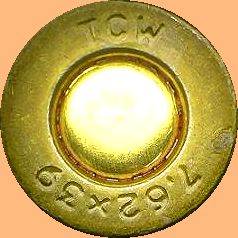5.45 x 39 mm
|
|
|
|
|---|
|
5.45 x 39 mm |
Re-Loading data and dimensions for 7.62 x 39 calibre |
|---|
| Disclaimer... This page is a collecting point for fragmentary information that comes to light during my wanderings through my old notes. As a result it may be incomplete or even contain some incorrect information. It would be unwise to rely on this page of information until this warning notice is removed. |
|---|
| Date... | Originator... |
| Bullet Dia... | Main Usage... |
| Die Set... | Intended barrel length... |
| Primer... | Max overall length... |
| Trim Case... | Max Case length... |
| Crimp... | Bullet Seating... |
| Shell holders... | RCBS... | Lyman... | Pacific/Hornady... | Bonanza... |

Case Dimensions ("W" = Water capacity)
| Bullet Type | Bullet Wt. Grains | Gas Check | Powder Type | Powder Weight Grains | Powder MAX Grains | Pressure C.U.P. | Pressure lb/Sq in | Muzzle Velocity ft/sec | Muzzle Energy ft lbs | TKO |
|---|---|---|---|---|---|---|---|---|---|---|
| Jacketed | 111 | 0000 | IMR 2222 | 33.3 Gr | 33.4 Gr | 44,444 | 55,555 | 6666 | 7777 | 88 |
Notes
|
The information given and photographs in this lighter coloured panel are mainly due to J.A. Freeman and are reproduced here with his permission. The 7.62x39 cartridgeThis was invented by the Russians and adopted as the M-43 cartridge in 1943, but was originally inspired by the German 7.92x33 cartridge and Mkb-42 assault rifle combination with it's 30 round magazine. Chinese Manufactured 7.62x39 mm
Chinese 7.62 x 39 HeadstampsThe top number indicates the number of the factory that produced the ammunition. The bottom number gives the year of production.
Commercial Packaged Chinese Ammunition
All the commercial ammunition was packed in the same style wooden crates as the surplus ammunition show above. The first commercial ammo that Jeff saw was the green box Norinco that was packed 20 rounds per box, 600 rounds per tin, and 2 tins per wooden case of 1200. After this initial batch all the ammunition was packed with sixty 20 round boxes per wooden case and all the boxes were wrapped in one large clear plastic bag.
| ||||||||||||||||||||||
 Tula Cartridge Works
Tula Cartridge WorksTula is known for the quality and reliability of its ammunition. Tula has been manufacturing all types of ammunition for over 100 years and in that time has produced hundreds of millions of rounds. There are very few manufacturers in the world that have more experience than The Tula Cartridge Works, whose staff take great pride in their products. Tula Cartridge Works initially produced ammunition with the TCW headstamp illustrated at right, which later became the WOLF brand. Early imports of Tula cartridges came in sinple white boxes with black lettering. Early imports of Wolf ammuntion into USA had TCW headstamps even though they were packed in 'Wolf brand' boxes. Now all the Wolf brand production has a WOLF headstamp. Variations do exist, but I have no documentation. |
Originated... 04 February 2007, Additions... 08 February 2007, Additions... 21 June 2007,
|